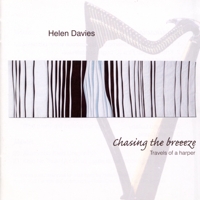Chasing the breeze by Helen Davies
Chasing the breeze, travels of a harper: There is a legend from the Western Isles of Scotland that tells of a harper who, on his travels, would sail into the creeks of the Isles, always at twilight. He would spend the evening at the headland house, where the “makers and hearers” of music would gather. At midnight he would pass the blessing around and put out to sea again, forever “tune-seeking and tune- making” ... These are tunes that I have gathered on my travels — from countries I have lived in or visited - from many of the wonderful musicians I have had the privilege of meeting along the way. Many thanks to all of you for your inspiration. Buy this album now CD: £12.00 + p&p |
| Please click here for Artist Information, Contact Details and other recordings |
Scandinavia
1 I denna Ijuva sommartid (In this lustrous summertime) Sweden
2. Kristallen den Fina (O bright crystal) Sweden
3. Minuet 60 Denmark
4. Minuet/Merch Megan Denmark/Wales
5. Heimo Norway
6. Polska Sweden
7. Ho Mar (The Mother) Norway
8. Dans, Proportion, Serras Denmark
Scotland
9. Shetland Lullaby
10. Roslin Castle
11. John Anderson my jo
Wales
12 Calennig
13. Miss Croke’s Minuet
14. Shawbury Park
15. Rhisiart Annwyl (Sweet Richard)
Ireland
16 Eili gheal chiúilin Ní Chearbhaill (Fair gentle Eillie
O’Carroll)
17. Eleanor Plunkett
18. Mrs. McDermot Roe
19. Cailin Deas Crúidhte Na mBo (The pretty girl milking her cow)
Japan
20. Akatombo (Red Dragonfly)
21. Kojo No Tsuki (A ruined castle in the moonlight)
CD Notes Chasing the Breeze These are tunes that I have gathered on my travels — from countries I have lived in or visited - from many of the wonderful musicians I have had the privilege of meeting along the way. Many thanks to all of you for your inspiration. I hope those of you who listen will have
as much pleasure in hearing as I have had in tune-seeking and tune-making. Heimo is a Norwegian song telling of the power of fhe water spirit to lure humans to his dwelling on the riverbed. Legend also has it that “spillemænd” (traditional musicians) often learnt their tunes from water spirits, so Heimo is followed by a lovely Swedish Polska (ever so slightly adapted to suit the Irish harp) found in Anders Larsson’s music book of 1810 from Østergotland. The Norwegian song The Mother captures the feeling known to all travellers, when the longing for home is almost unbearable. Scotland Roslin Castle is a slow air named after a castle in Scotland, which was built around 1304. The chapel of the castle is famous for its architectural beauty. There is also a Welsh version of this tune called Rhos-Y-Llan Castle. The earliest Scottish description of a country dance with music is to be found in the Agnes Hume manuscript of 1704. The tune used is John Anderson my jo — a tune later used by Robert Burns for a song describing the beauty of lovers growing old together. Wales Ireland Japan Red Dragonfly (Kosaku Yamada d.1965) recalls the feelings of the poet (Rofu Miki) when he thinks of his home and of his love for his mother. A ruined castle in the moonlight (Rentaro Taki d.1903) brings this particular journey to a close in calm and reflection, as the composer sits on the stone wall of a ruined castle playing his shakuhachi — the instrument of Zen meditation which a contemporary poet has described as “strength in the face of the wind” — very essential when Chasing the Breeze...
Credits Recorded and mastered by Thomas Li at My Room Studio, Copenhagen. Produced by Thomas Li. Cover textile by Lesia M. Zuk. Dedicated to the memory of Rikke Gaarde who is now “one of the thousand winds that blow” around us. |
| Instruments: | Solo harp |
| Genre: | Traditional |
| Format: | CD |
| Our Ref: | A0159 |
| MCPS: | RAINCD 8011 |
| Label: | Exlibris Musik |
| Year: | 2007 |
| Origin: | Denmark |
